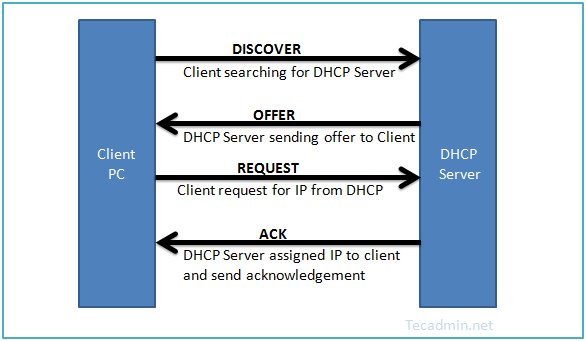
Step 1: Install DHCP Package
First install dhcp packages using package manager yum on CentOS, Redhat system.# yum install dhcp
Step 2: Edit /etc/sysconfig/dhcpd file
Firstly we need to set ethernet interface name as DHCPDARGS in /etc/sysconfig/dhcpd file. Edit this configuration file and update the ethernet name.DHCPDARGS=eth1
Step 3: Configuring DHCP
DHCP creates an empty configuration file /etc/dhcp/dhcpd.conf. Also it provides a sample configuration file at /usr/share/doc/dhcp*/dhcpd.conf.sample, which is very useful for configuring the DHCP server.So as a first part, copy content of sample configuration file to main configuration file. Sample configuration file may be changed as per version you have installed on your system.
# cp /usr/share/doc/dhcp-4.1.1/dhcpd.conf.sample /etc/dhcp/dhcpd.conf
3.1 – Parameter Configuration
First configure the basic options which is common to all supported networks.option domain-name "tecadmin.net"; option domain-name-servers ns1.tecadmin.net, ns2.tecadmin.net; default-lease-time 600; max-lease-time 7200; authoritative; log-facility local7;
3.2 – IP Subnet Declaration
First edit dhcp configuration file and update subnet details as per your network. For this example we are configuring DHCP for 192.168.1.0/24 LAN network.subnet 192.168.1.0 netmask 255.255.255.0 {
option routers 192.168.1.254;
option subnet-mask 255.255.255.0;
option domain-search "tecadmin.net";
option domain-name-servers 192.168.1.1;
option time-offset -18000; # Eastern Standard Time
range 192.168.1.10 192.168.1.100;
}
3.3 -Assign Static IP Address to Host
In some cases we need to assign a fixed ip to an interface each time it requested from dhcp. We can also assign a fixed ip on basis of MAC address (hardware ethernet) of that interface. Setup host-name is optional to set up.host station1 {
option host-name "station1.example.com";
hardware ethernet 00:11:1A:2B:3C:AB;
fixed-address 192.168.1.100;
}
Step 4: Restart DHCP
After making all above changes, lets start dhcp service using following command.# service dhcp startSimilarly to stop and restart dhcp service use following commands.
# service dhcp stop # service dhcp restart
Step 5: Setup Client System
At this stage we have a running dhcp server which is ready for accepting requests and assign them a proper ip. but to verify I have another CentOS machine running on same LAN. Now login to that client machine and edit ethernet configuration file.# vim /etc/sysconfig/network-scripts/ifcfg-eth1 DEVICE=eth1 BOOTPROTO=dhcp TYPE=Ethernet ONBOOT=yesMake sure BOOTPROTO is set to dhcp.
Let’s restart network services on client system. You will get that dhcp server assigned an ip address from defined subnet. If you have connected to client pc from remote login, Your session can be disconnect.
# service network restart
Không có nhận xét nào:
Đăng nhận xét